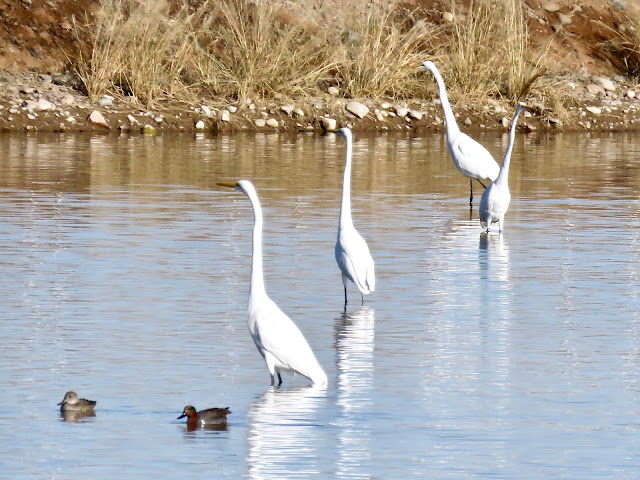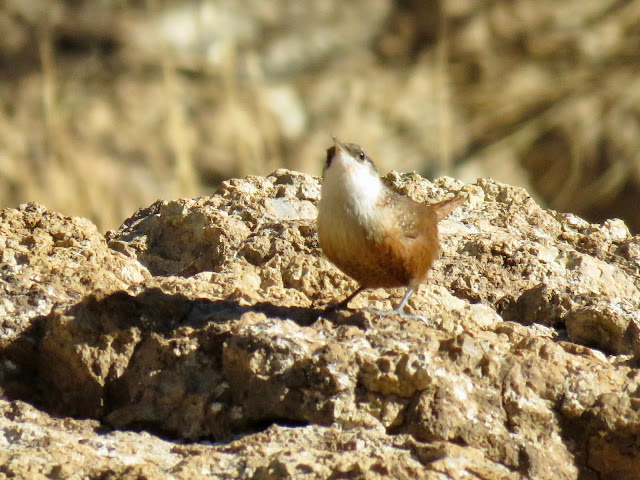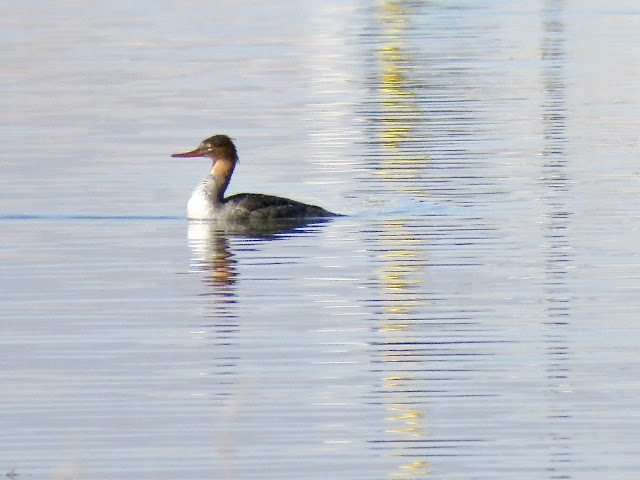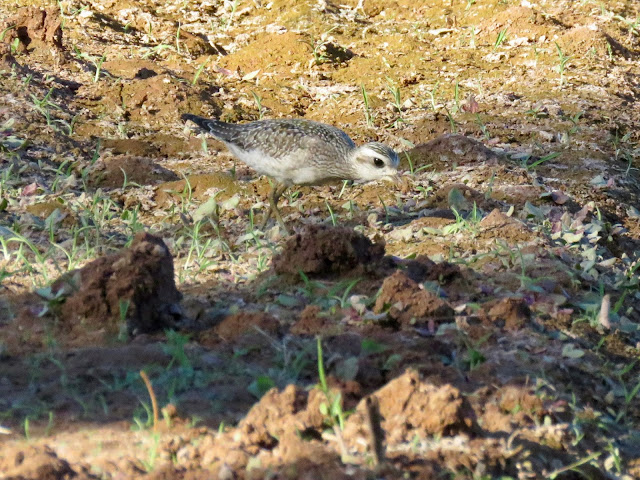Monday, November 27, 2017
As you’ve noticed in birding field guides, all our birds (classified as Aves) are organized into categories beginning with a) Orders into b) Families; each family into c) genera; each genus into d) species; and species into e) subspecies. Having learned birds in the field by identifying them in field guides instead of by book-learning (school) means that I don’t always know exactly which category to use when referencing them.
TYRANT birds have always fascinated me and last week I was fortunate enough to catch sight of a quite rare COUCH’S KINGBIRD in Tucson. In addition to our eight North American kingbirds, both the Scissor-tailed and Fork-tailed Flycatcher are in that genus (Tyrannus).
 |
| COUCH'S KINGBIRD, its yellow front brilliant in the rising sun |
According to Cornell’s web site “All About Birds”:
The scientific name Tyrannus means “tyrant, despot, or king,” referring to the aggression kingbirds exhibit with each other and with other species. When defending their nests they will attack much larger predators like hawks, crows, and squirrels. They have been known to knock unsuspecting Blue Jays out of trees.
The kingbird eats insects but will grab larger available food, carry it back to its perch, beat it down, then swallow it whole. I have yet to see a kingbird do that in the field but I like this bird for its behaviors and handsome appearance.
 |
| Rare COUCH'S KINGBIRD, Fort Lowell Park & Pantano Wash, Tucson, AZ |
Looking at a range map in your field guide, you’ll notice COUCH’S KINGBIRD is shown only in south Texas, a few states eastward along the Gulf coast, and Mexico. Its range does not show up in Arizona at all; there have been only two prior records of it in the state. Found and photographed by Melissa (Rava) Williams on November 11, 2017, this bird will be the third record if supporting data is approved by the American Birding Association (ABA). Thank you, Rava! Even though almost two weeks had elapsed since her sighting, the bird had been reported the day before we arrived on November 22nd.
 |
| COUCH'S KINGBIRD, Tucson, AZ 11/22/17 |
Look where this bird perched - up high, on an open limb giving it a great view of food around it. It waits, then sallies forth, catches an insect, brings it back (often to the very same perch) to eat it. Then repeats the action. Since I carry a camera, that behavior is perfect! (Unlike a 6” warbler that fidgets behind big cottonwood leaves showing only a tail or beak and is rarely still enough to photograph!)
A Life Bird for Hinde Silver who joined me for the ride to Tucson, we expected it might take hours, as others had reported, before we spotted this rare COUCH’S KINGBIRD. Arriving at 8 a.m., we walked Ft. Lowell Park in Tucson until 8:20 when we, along with a Tucson couple who had stopped by to get a “Lifer” before work, spotted it. Big score for them and we were thrilled.
When I saw the COUCH’S KINGBIRD in Texas the first time, it became “normal” quite quickly as it seemed always waiting for us to pull into a wildlife refuge parking lot each morning. It was vocalizing there but was quiet the morning we observed it in Tucson. More similar in appearance to the Tropical Kingbird than either of our more common Cassin’s or Western Kingbirds, it was still quite a thrill to find and see this Texas kingbird in our own backyard, so to speak.
When I saw the COUCH’S KINGBIRD in Texas the first time, it became “normal” quite quickly as it seemed always waiting for us to pull into a wildlife refuge parking lot each morning. It was vocalizing there but was quiet the morning we observed it in Tucson. More similar in appearance to the Tropical Kingbird than either of our more common Cassin’s or Western Kingbirds, it was still quite a thrill to find and see this Texas kingbird in our own backyard, so to speak.
_ _ _
Arizona seems to be having one rarity after the other show up, even if for a day or two. Not always able to get out to see these rarities immediately, I hope for the best but sometimes “dip” (miss out) when I arrive too late. Yesterday, for instance, which would have been just the second day for the Brant and a California Gull to remain at Glendale Recharge Ponds, I arrived 15 minutes too late (7:15 a.m.) to catch the Brant, and the gull was long gone.
_ _ _
It was also Day #2 for two rarities I wanted to see at Gilbert Water Ranch when Jannie Blok and I began looking for them at 7:15 a.m.the day after Thanksgiving. The SURF SCOTER (ocean bird, as its name implies) was still swimming around in the small remnant pond area of Pond #6 that was just beginning to be filled again with final stage treatment water. To be so close (50’ or less) to an ocean bird is highly unusual so I snapped many photos to document this unusual fresh-water sighting in Arizona. Morning light was not good for this species, but the photos document the sighting.
 |
| SURF SCOTER - TWO ABOVE PHOTOS |
Also at the edge of this small pond, now extending its boundary with the influx of new water, were two geese that are found infrequently at this location: SNOW GOOSE and GREATER WHITE-FRONTED GOOSE.
 |
| GREATER WHITE-FRONTED GOOSE (above & below) |
 |
| Similar to but different from the barnyard Graylag Goose |
 |
| Juvenile SNOW GOOSE--not yet completely white feathered |
 |
| Showing its "grin patch" on lower mandible (helpful ID mark) |
These three waterfowl above were our consolation for the now-absent Northern Saw-whet Owl, reported on Thanksgiving Day.
I also made my 4th attempt at finding the rare Chestnut-sided Warbler in its favorite cottonwood trees (along with other birders), but lacking sufficient time to stay until I got it, I needed to leave after 45 minutes of spotting other good warblers instead.
On a recent visit to Butcher Jones, I saw over a dozen PIED-BILLED GREBE.
On a recent visit to Butcher Jones, I saw over a dozen PIED-BILLED GREBE.
 |
| Pied-billed Grebe |
Back to our day in Tucson. After finding the COUCH'S KINGBIRD so quickly in the morning, we drove up to Sweetwater Wetlands where we found not only the usual birds but the very unusual - not rare - Bobcat!
 |
| After letting us walk past it on the other side of the road-wide trail, the Bobcat watched as we moved on. |
Far from another trail as we looked over some dry settling basins, we spotted a Coyote.
 |
| Coyote in the eastern-most basin at Sweetwater Wetlands |
With the arrival of cool weather (mid to high 80s in the afternoon), I've been birding almost nonstop each morning. Other nifty sightings include:
 |
| AMERICAN KESTREL |
 |
| PRAIRIE FALCON - Rousseau Sod Farm, Central Arizona [above & below] |
 |
| Whistling back and forth to this mimic (GREAT-TAILED GRACKLE), for a half hour or so, when we picked up the scope and headed quite a distance toward my car, it flew right over and landed there! |
Yesterday, when I missed two rarities at Glendale Recharge Ponds, lots of other birds were present:
 |
| Osprey |
 |
| LEAST SANDPIPERS |
 |
| NEOTROPIC CORMORANT |
 |
| Two (M&F) GREEN-WINGED TEAL with four GREAT EGRET |
 |
| Two GREAT EGRET |
It felt wonderful to be able to go out at dawn and stay until I felt like I had documented all the birds and critters I knew at a specific location instead of being driven back to my air-conditioned house to escape summer temperatures that lasted through most of October.
* * *











































